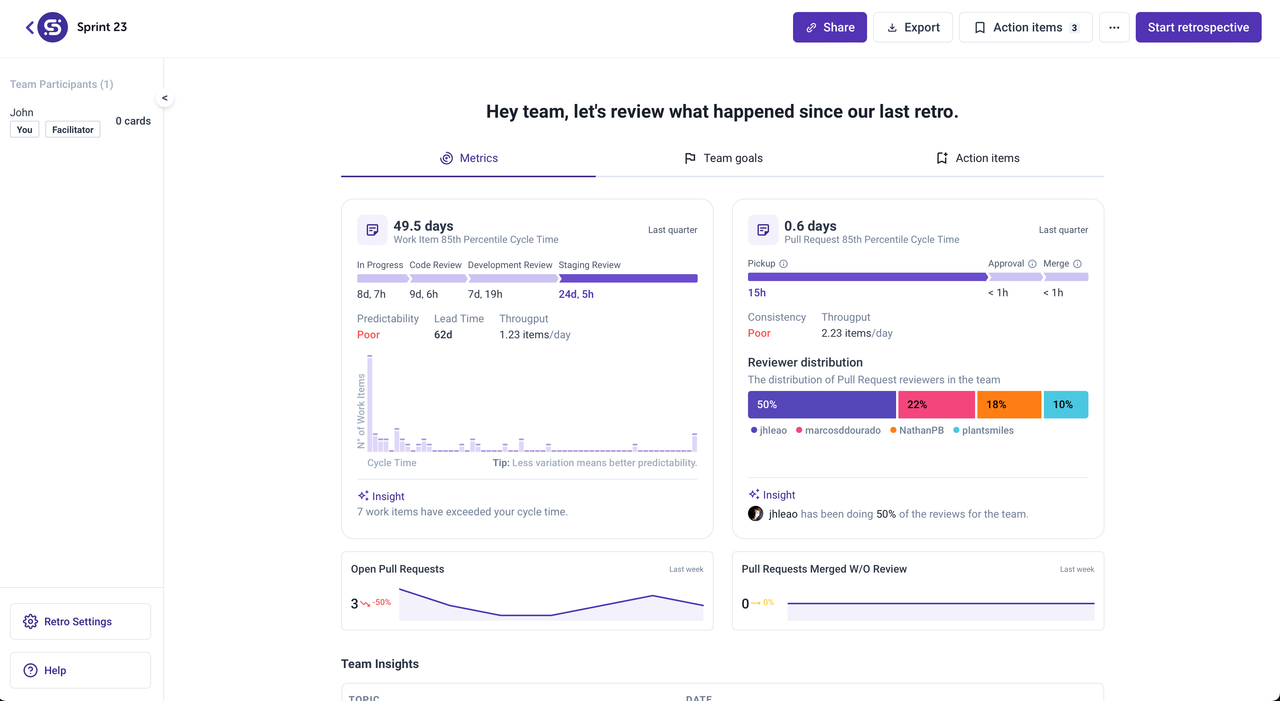In the world of software development, retrospectives play a crucial role in fostering team growth and continuous improvement. By incorporating engineering metrics into your retrospectives, you can take your software development process to new heights. In this blog post, we will explore the benefits of integrating metrics into retrospectives and share best practices for making data-driven decisions that boost productivity and collaboration.
Why Engineering Metrics Matter in Retrospectives
Retrospectives are an essential Agile practice that provides software teams with a structured way to reflect on their performance and identify areas for improvement. While qualitative feedback is invaluable, adding quantitative engineering metrics to the mix can paint a clearer picture of your team’s performance and ensure more effective decision-making. Here’s why engineering metrics matter in retrospectives:
- Objective Data for Informed Decisions: Engineering metrics offer an objective view of your team’s performance, enabling more accurate identification of bottlenecks and inefficiencies.
- Increased Accountability: Metrics make it easier for team members to take ownership of their performance and actively engage in improvement efforts.
- More Collaboration: Sharing metrics within the team fosters a culture of transparency, encouraging open discussion and collaboration.
- Streamlined Focus: Metrics help your team prioritize their efforts and concentrate on the most impactful areas for improvement.
Incorporating Engineering Metrics into Retrospectives: Best Practices
Now that you understand the value of engineering metrics in retrospectives, here are some best practices for integrating them into your process:
- Select Relevant Metrics: Choose the engineering metrics most relevant to your team’s goals and objectives. Common examples include cycle time, lead time, deployment frequency, and error rates.
- Visualize Data: Present your metrics in a visually engaging manner to make them easily understandable and actionable. Consider using charts, graphs, or dashboards to display your data.
- Establish a Baseline: Before diving into the data, establish a baseline for each metric to help your team understand their current performance and track improvements over time.
- Facilitate Data-Driven Discussions: Encourage team members to discuss the metrics and insights in the context of their experiences and perspectives. Use the data as a starting point for identifying areas for improvement and creating action plans.
- Track Progress: Continuously monitor your team’s progress by tracking the impact of implemented improvements on the selected metrics. Adjust your action plans as needed to ensure ongoing development process optimization.
Integrating Metrics into Retrospectives with ScatterSpoke
ScatterSpoke makes it incredibly easy for you to bring engineering metrics into your retrospectives, allowing you to optimize your software development process and drive team growth. Here’s how you can leverage ScatterSpoke to integrate metrics into your retrospectives:
- Connect Your Tools: Integrate ScatterSpoke with the development and project management tools your team already uses, such as Jira, GitHub, or Bitbucket. This allows ScatterSpoke to automatically collect relevant engineering metrics and automatically get a baseline for your team.
- Review Your Metrics And AI-Driven Insights: ScatterSpoke’s AI-driven insights provide valuable context and recommendations for improvement based on your team’s metrics and performance data. Reviewing those along side your team’s metrics during our facts and stats phase of the retrospective will help you streamline your teams focus on what is really holding you back from delivering more value.
- Track Progress and Iterate: Monitor your team’s progress within ScatterSpoke by tracking the impact of implemented improvements on the selected metrics from your retrospective’s action plan. When its time for another retrospective, repeat the process to see what made the biggest impact from the last retrospective.
Conclusion
By incorporating engineering metrics into your retrospectives, you can foster a data-driven culture. The combination of quantitative and qualitative data empowers teams to make informed decisions, boost productivity, and enhance collaboration. Start integrating engineering metrics into your retrospectives with ScatterSpoke today and experience the transformative effects on your team’s performance and growth.
